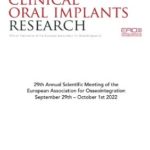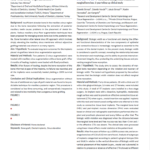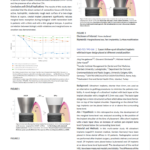 The 29th EAO Congress (European Association for Osseointegration) took place in Geneva, Switzerland, from September 29 to October 1, 2022.
The 29th EAO Congress (European Association for Osseointegration) took place in Geneva, Switzerland, from September 29 to October 1, 2022.
We actively participated in this annual, highly prestigious dental implantology event through a poster presentation of a novel two-phase dental implant concept known as the “Connective Tissue Level Implant”.
In the special issue of Clinical Oral Implants Research – the most cited oral implantology journal, an abstract of the presented study was published, where biological width is considered as a mucosal immunological system capable of ensuring the integrity of the internal environment, thus protecting the underlying tissues and preventing marginal bone resorption (periimplantitis).
The study evaluates the clinical performance of a novel dental implant concept in relation to biological width violation. Biological width violation is diagnosed when the vestibular distance between the marginal bone level and the free mucosa (PMv) is less than 3 mm and/or in the absence of effective Connective Tissue Attachment (CTA).
Effective Connective Tissue Attachment (CTA) and Junctional Epithelial Attachment (JEA) are made possible by the dual-zone transmucosal part of the implant with a hydrophobic smooth abutment part and a hydrophilic, moderately rough fixture neck surface, stimulating the formation of connective tissue attachment in the case of supracrestal insertion. In addition, the smooth surface of the epithelial zone in the sulcus area minimizes plaque formation and accumulation.
The highest marginal bone loss at five years after implant placement (−1.12 ± 0.86 mm) was found in implants with the most severe biological width violation due to an insufficient dimension of the peri-implant mucosa (PMv <3 mm), as well as the absence of effective connective tissue attachment (CTA) at the beginning of the biological width restoration process.
On the other hand, a statistically significant reduction (p=0.0002) of bone loss at five years after implant placement (−0.13 ± 0.53 mm) was demonstrated in implants where the biological width was fully respected in terms of the sufficient size of the peri-implant mucosa (PMv >3 mm) and the presence of effective connective tissue attachment (CTA).
Based on the clinical results, the study has shown, inter alia, that marginal bone loss depends on the degree of biological width violation in its vertical dimension, as well as in the functional attachment of its two components, epithelial and connective tissues, in the transmucosal zone of the implant. The study demonstrated a positive correlation between biological width violation and marginal bone resorption.
The abstract was published here:
Strnad Z, Novak Z, Strnad J, Nesvadba R, Kamprle J.: The effect of biological width violation on marginal bone loss. 5-year follow-up clinical study. Clin Oral Implants Res. 2022;33(S24):182-3


